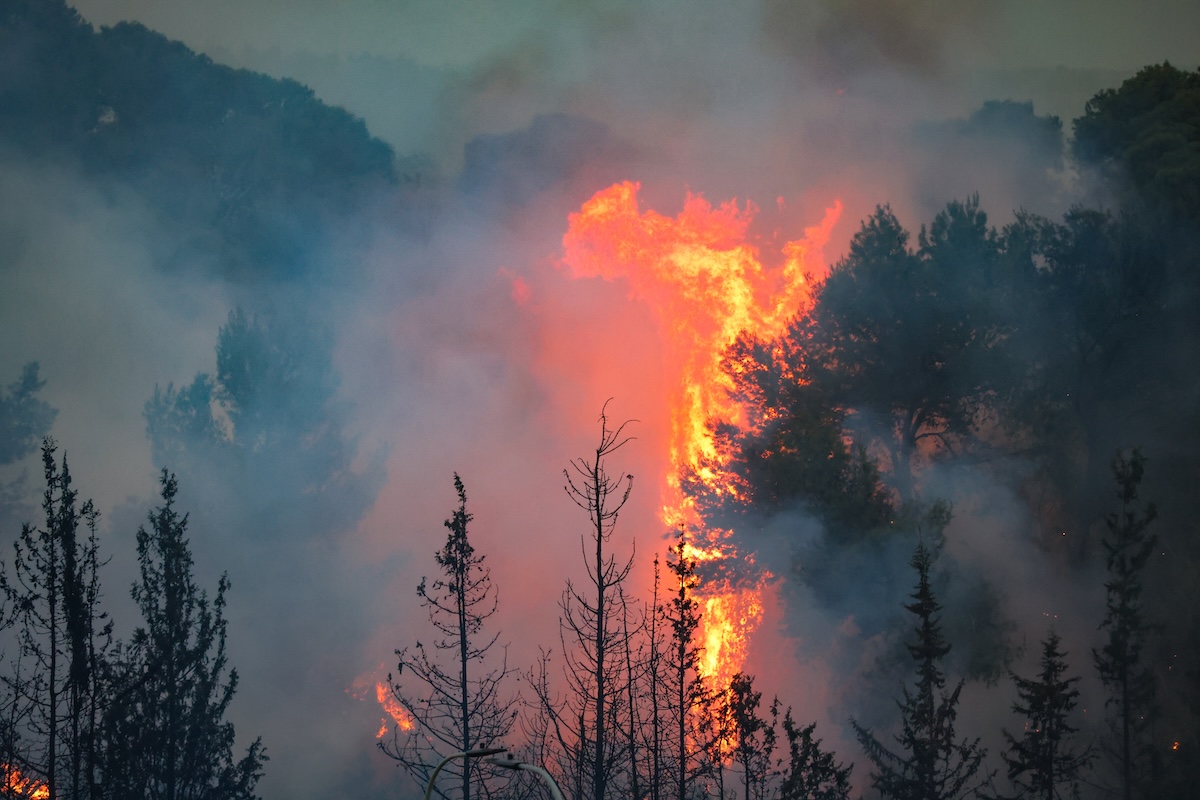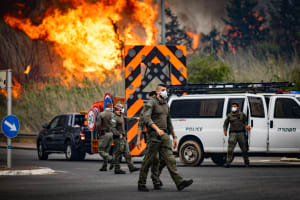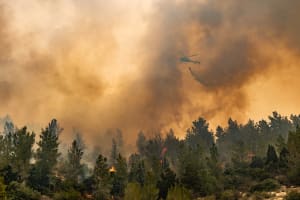Jerusalem area wildfires still rage but evacuated residents allowed to return; 18 suspected arsonists arrested, claims PM Netanyahu
Firefighting planes arrived from Cyprus, Italy, Greece, Croatia and France

The large wildfires that swept through the Mateh Yehuda Regional Council – a county located west of Jerusalem – on Wednesday, injuring 21 firefighters and threatening homes in multiple towns, continued to burn into Thursday.
However, despite the Fire Authority saying that its efforts continued “at full intensity,” residents of almost a dozen evacuated communities were allowed to return to their homes after the advance of the flames was halted and all roads were reopened.
While the fire service has not yet officially determined the cause of the large blaze in the Latrun area, which cut off Highway 1 between Jerusalem and Tel Aviv for hours on Wednesday, the prime minister indicated that arson may have played a large role.
This morning: Firefighting efforts continue – 20,000 dunams on fire, Canada Park hardest hit*
— DeepState Illuminate (@TheDeep_State6) May 1, 2025
The Israel National Fund (KNF) is updating this morning (May 1) that the large-scale fires that broke out yesterday in various areas of the central region have caused severe… pic.twitter.com/ftSYmktiCR
“This is not a simple matter, there are natural damages and there are also human injuries. We are currently holding 18 people who are suspected of arson, with one who was caught in the act,” Prime Minister Benjamin Netanyahu said.
Police sources told media outlets that only three of the 18 were directly connected to arson. The others may have been arrested due to incitement for arson, as after the outbreak of the fires, a large-scale online campaign on Arabic social media accounts had called on Palestinians to set more blazes.
“There is hard work here, our neighbors, who claim they love this land, are willing in their incitement and speak of burning the land, while we are lovers of the land and are preserving it,” Netanyahu said.
While several reports indicated that some fires were started by arson, the main fire near Latrun began in an area where another large fire had been extinguished only two days before, making it possible that the fire reignited and spread from there.
On Thursday, the Fire Authority stated that it would concentrate “maximum efforts” in the early afternoon to achieve full control by the late afternoon hours, before the winds were expected to intensify again.
The fires started on Wednesday amid hot and dry desert winds, called hamsin in Arabic and sharav in Hebrew. Toward the evening, temperatures dropped by almost 10 degrees Celsius and light rain fell in some areas.

According to an update early on Thursday afternoon, 93 teams were still engaged in “intensive activity” to stop the spread of the fire. There were active centers in the areas of Latrun, the Burma Road, Eshtaol, Mesilat Tzion, Ta’oz, Canada Park and Sha’ar HaGai.
An estimated 20,000 dunam (20 square kilometers or 8 square miles) were consumed by the fires, including almost the complete area of the Ayalon-Canada Park, located north of Highway 1.
The unusually large area covered by the main fire, as well as several other small fires across the country, necessitated a general call-up of firefighters across the country, substantial efforts by the security forces, as well as calls for help from abroad.
On Thursday, the Fire Authority reported that its operations “continue in a significant effort in cooperation with IDF forces and the Home Front Command to create firebreaks using heavy engineering tools to protect the communities from the spread of the fire.”
Around noon on Thursday, the first firefighter teams arrived from Cyprus, including a helicopter. Firefighting planes from Italy, Croatia, Greece and France were also expected to arrive later in the day.
In addition to deploying engineering tools, the IDF activated several other units to help in the effort. The Operations Division of the Intelligence Directorate operated and coordinated resources to analyze the fire area and direct firefighting and rescue forces on the ground.
Visual Intelligence Unit 9900 utilized satellite imagery and other visual tools, which were analyzed to identify, interpret, and map the main fire centers. Other intelligence units worked to ensure that real-time information was accessible to firefighters in the field.
The Israeli Air Force contributed with logistical support and operated six Super Hercules aircraft to drop fire retardants. In addition, a battalion of officer cadets joined Home Front Command troops in constructing fire lanes around the settlements in the Jerusalem hills.
Israeli police forces reopened the numerous blocked roads and towed many vehicles abandoned on Highway 1 as the fires approached, relocating them to a parking lot near Latrun.

The All Israel News Staff is a team of journalists in Israel.














